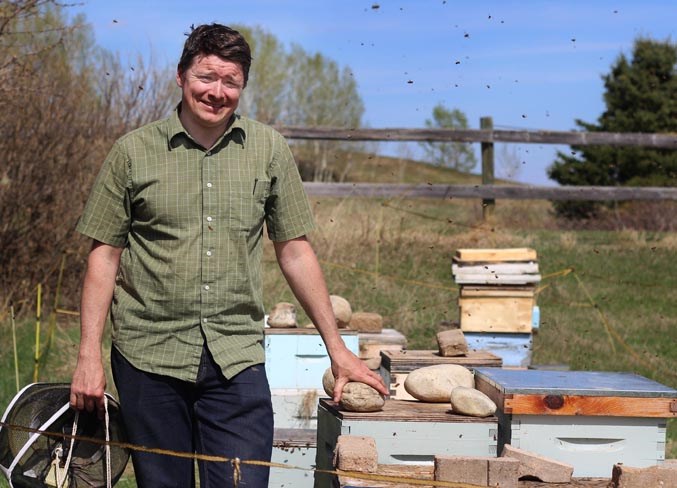"My hand's a little sticky, sorry," said William Pratt after pulling off his bee keeper's hat and veil. Using bare hands, Pratt of Ol' Grumps' Honey had worked away the afternoon separating his bee hives at a rural property off of Horsecreek Road. "You just divide the bees and the broods so that's the larva and the eggs and everything into two sections. there's only one queen so one side will have the queen and the other side won't. Then you put a new queen in the other one," he said, noting his new queen will come from Hawaii. "It's hard for us to get our queens ... just cause you need warm weather for queens to mate and that kind of stuff. The goal, he said, was to separate half of his bees away from their current queen to create a new colony which will help re-establish the population of his bees. This past winter, Pratt said about 30 per cent of his hives died, partially due to the particularly brisk weather this year. He explained bees typically like to leave the hives during the winter when the weather is more tepid to take a "cleansing" flight. However, due to the lack of Chinooks this past winter, the bees may have had fewer opportunities to do so, leaving the hives in less ideal conditions. "It's a little more than I'd like. Ten to twenty (percent) is kind of normal...that used to kind of be the standard. In the last year or couple years they've been losing a couple more," Pratt said. While the loss is not ideal, Pratt, who sells the honey at farmer's markets in Calgary and Cochrane with his wife, said he isn't worried. "This is the thing about honey bee colonies - you kind of see these big numbers, big losses but we can make them up fairly easily," he said. Pratt isn't the only Albertan bee farmer who lost a large share of his bees. Greidanus Honey Mill, the largest bee farm in the province, also lost 30 per cent of its 6,000 hives. Mike DeJong, the President of the Alberta Beekeepers Commission, said while it isn't easy to bounce back from the loss, the warm weather lately has provided the perfect conditions for the bees that did make it through the winter. "This weather we've been getting is great and the bees are bouncing back," DeJong said. "Is it easy to jump back? No. The guys who had harder losses, it's tough to make something out of nothing, right? I mean in some cases it could take a couple of years to get their strength back and they might make less of a crop, but it takes a lot of money and investment and time to rebuild." Each queen can be about $40 he added, which means replacing 1,800 hives would cost a producer $72,000. "In my case, we had a higher loss than normal too, but I think we're going to jump back. It all depends on the weather," DeJong said. He said it will be "a wait and see kind of game," and everything will depend on when flowering starts.




